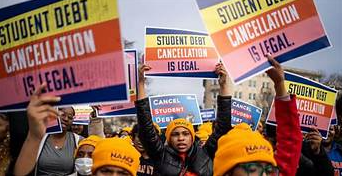Federal student loan borrowers could expect to begin repaying their bills in late summer as the larger question over loan forgiveness hangs in the balance.
Federal student loan borrowers are facing a reckoning as a result of the tentative debt ceiling deal struck in Washington.
If the agreement between the Biden administration and top congressional Republicans is signed into law, payments on federal student loans that were paused at the start of the pandemic will be reinstated at the end of August, with those bills coming due the following month.
That means some 43 million borrowers like Daniel Galván, a 34-year-old from Southern California, must start tightening their household budgets amid higher food costs and other unforeseen expenses. Galván, a university administrator who still owes about $10,500 on his student loans, said payments may have stopped over the last three years, but his financial obligations only grew.
“The pause was helpful,” he said Tuesday. “My wife and I could buy a house in 2020. The money that would have gone to a loan payment helped me save up for that house and our initial expenses. Now, we have 1-year-old twins, and they are not cheap.”
In March 2020, then-President Donald Trump signed the CARES Act, which allowed federal student loan holders to forgo payments without being penalized. President Joe Biden extended the pause as concerns about inflation and rising gas prices continued to sap consumers.
Interest on federal student loans was also suspended to the benefit of borrowers. The moratorium, however, did not apply to borrowers with privately held loans.

